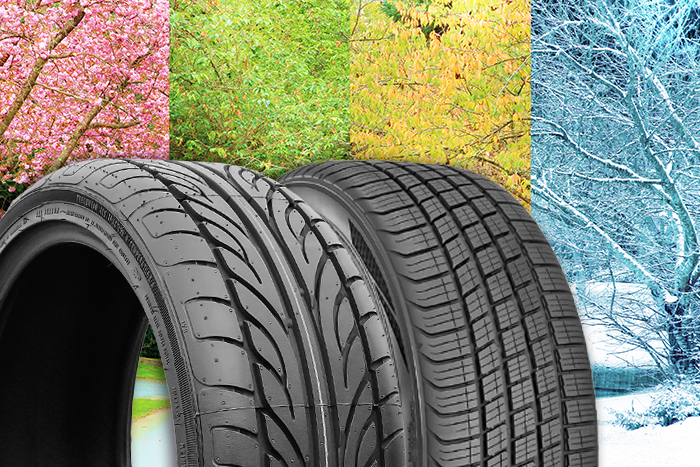
The question of all season vs all weather tires has been widely discussed ever since all weather models started popping up on the tire market. But, what exactly is the difference between these tire categories?
Well, both all season and all weather tires have their positive and negative characteristics, as all things do. Which tire set would work for you will greatly depend on your driving habits, driving climate, and location, among other things.
Let us guide you through everything you need to know about all weather vs all season tires, so you can see which are the better tires for you.
Table of Contents:
- Why Are All Season Tires So Popular?
- The Difference Between All-Season and All-Weather Tires
- Then, What Is an All Weather Tire?
- All Weather Tires vs All Season Tires
- Are All Season Tires Good for Winter?
- Ensure Year-Round Traction With All Weather Tires
- For Harsh Winter Weather, Get Winter Tires
- Frequently Asked Questions
Why Are All Season Tires So Popular?
When deciding if you need all season or all weather tire models, it is important to know the difference between them. So, first, let's discuss what are all season tires and why are they popular on the tire market!
Well, all season tires, or as they are also known 3-seasonal tires, are tires designed to handle a variety of weather conditions. That is, the all season tire temperature range stays above 40ºF. While they ensure excellent traction in mild to hot temperatures, cold winter conditions can pose a threat to their driving safety. All season tires in snow do not offer the same traction levels as they do on dry and wet roads.
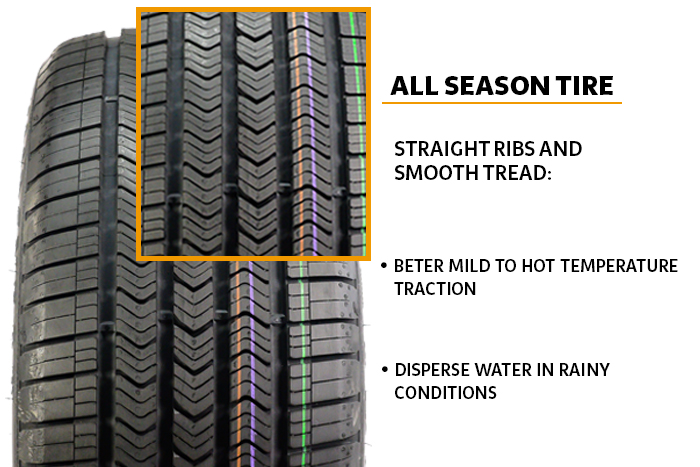
But then, why are they so widespread? The answer is simple.
All season tires offer the widest application variety. While their snow traction is not the best, they are still considered all purpose tires in a way. From good dry and wet grip, excellent controllability, and better fuel economy to lengthened tread life and high driving comfort levels, all season tires off it all!
The Difference Between All-Season and All-Weather Tires
Whether you need all weather or all season tires will be determined by your driving conditions. Let's face it, not everyone lives in a climate where 3-peak tires are necessary. But, for those who do, it can be the difference between life and death.
This may seem like a harsh sentiment, but it is the truth. Most all season tires for winter do not offer the necessary traction on ice- and snow-covered roads. Going from here, the main distinctness between all-weather tires vs all-season tires is the traction they offer.
Then, What Is an All Weather Tire?
All weather tires perform exceptionally well even in harsh winter conditions. For this reason, they have earned the 3-peak mountain snowflake rating and the 4-season tires name. These are better tires for snow and ice traction, which also offer great hydroplaning resistance, making them perfect for areas that experience severe winter months.
By mounting such all year tires on your vehicle, you eliminate the need for seasonal tire changes, but there is a downside. As these tires are truly used year round, their tread life is shorter compared to all season radial tires.

On the other hand, all year-round tires with snowflake symbol offer better winter traction. In other words, compare tires in the all weather and all season categories, and you will see that good all weather tires offer a safer performance in colder temperatures (even below 40ºF) than all season ones.
The all weather tires symbol is the 3PMS rating, which is earned with the detailed tread design and the durable compound blend. However, the all season tires' temperature range does not go below 40ºF.
All Weather Tires vs All Season Tires
When it comes to the difference between all-season and all-weather tires, the biggest ones are their traction and tread life. Let's see:
- All season radials, which are not 3-peak snow-rated tires, do not offer the same winter grip as all weather tires do.
- Most all season models are better wet weather tires than snowflake symbol tires (as they are better for snow and ice traction).
- Due to the compound blend used, all weather tires suffer from shortened service life compared to all season ones.
- All season tires are designed to offer better comfort levels, fuel economy, handling, and dry and wet weather performance, while all weather models focus on their year-round traction.
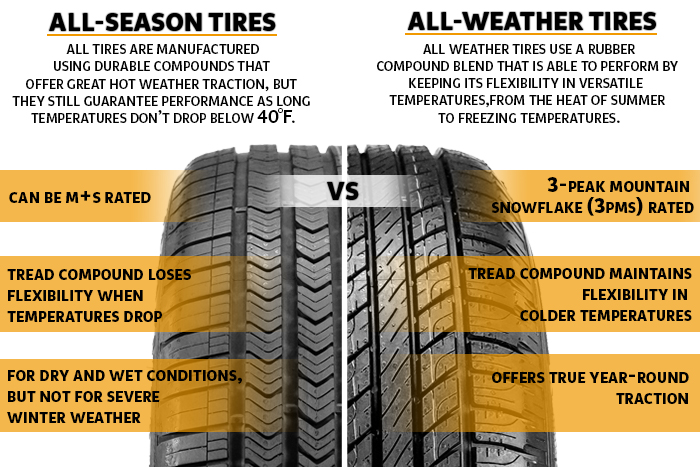
Are All Season Tires Good for Winter?
It might be confusing (because it is in the name) but all season tires are not all climate tires. Unlike their name suggests, all season models are not for year-round use. They are more like 3 season tire models, which are not tires with mountain snowflake symbol.
Such models do not provide the necessary traction in severe winter conditions. If you live in climates where winter tires are necessary, investing in good all weather tires for snow will be a better option.
All Season Tires Are Really Just 3 Season Tires
Spring, summer, and fall - these are the seasons when "all season" tires should be used. Is this a trick or a really bad wordplay? Sadly, it's neither. All season tires used to be considered the perfect mix between summer and winter tires, but that is not the case. For this reason, they are often referred to as three season tires.
Their tread designs lack the intricate details of winter tires, but their compounds withstand the heat of summer. Unfortunately, their compound blends do not offer the same temperature flexibility as all weather radial models do. They offer excellent performance and driving durability in temperatures below 40ºF. Additionally, all season tires are long tread life tires that are also designed to ensure driving comfort and fuel efficiency.
Ensure Year-Round Traction With All Weather Tires
All weather radial tires compare to all season models, but they offer better winter traction. Thanks to their detailed footprints, such tires are more suitable for performance in heavy rain and on ice- and snow-covered roads. Furthermore, their compounds ensure that the all weather tires' temperature range is better.
They are true four season tire models, as they are able to handle different weather conditions. They are also three peak mountain snowflake tires, which provide severe winter grip, but they do not suffer premature wear in summer conditions (like winter tires). They are good rain tires as well, thanks to the wider and deeper groove pattern they often sport.
The Downsides of All Weather Tires
The biggest of new all weather tires is their longevity. When it comes to the service life length of all weather vs all season tires, all season models tend to last longer. But, why is this?
An all weather snowflake tire will be mounted on the vehicle and used throughout the year, constantly. On the other hand, all season models often get a break in the winter months. This means that the difference between tires in these categories is the frequency of their use.
Nowadays, you can easily find tires that come with 80,000-mile treadwear warranties. However, so far tire manufacturers only provide these extravagant warranties with their all season products. All weather models, with the three-peak mountain snowflake symbol, typically receive around 50,000-mile warranties.
Therefore, these 3-peak snowflake tires provide great year-round traction, but their service life is the trade-off.
For Harsh Winter Weather, Get Winter Tires
Long ago only two types of tires existed: winter tires and summer tires. The difference between summer and winter tires was, as their names suggest, their capability to produce traction in hot and cold temperatures. Later, all season or all weather tires were also invented. Still, knowing what we know about tires, it is safe to say that true winter tires offer the best winter-weather traction.
Winter tires are the best for severe winter conditions thanks to their:
- High-density siping details across the entire tread area, which often use zigzag-shaped and 3D sipes
- Large bulky blocks make up directional or asymmetric tread areas
- Wide and deep grooves that channel water and slush away from the footprint
- Durable compound blends that keep the tire flexible in freezing temperatures
In certain climates and geographical areas, dedicated winter tires are the best option. Even more so as these tires can come in studded variations. Studded tires provide exceptional ice and snow traction, as they are able to dig into the tread area, creating a higher number of biting edges. But, even if you don't want or need studded traction, winter tires are still the safer bet for severe weather conditions.
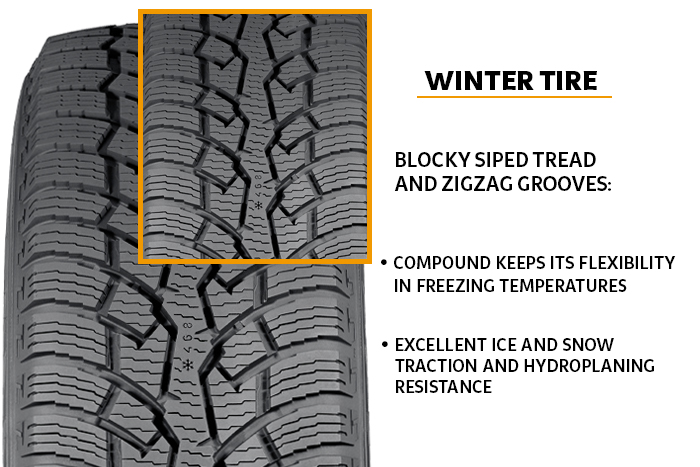
The problem with winter tires comes from their blocks and robust tread areas. While these tread elements ensure the traction necessary, they hinder traction in warmer temperatures. Furthermore, these tires are molded using softer compounds that keep their flexibility in freezing conditions. But, this softness is their doom when temperatures rise as it cannot combat heat build-up and premature wear.
All Weather vs Winter Tires
If the difference between all season and winter tires is that all season tires lack the three-peak mountain snowflake symbol, then what about all weather tires?
At first glance, the all weather tire symbol is the same as the winter tire one. This is true. Their tread area seems to be a hybrid between all season and winter tires, but is that really the case? All weather tires feature larger tread elements with a detailed siping pattern, as well as wide grooves. So, this means that these tread designs provide excellent summer and winter traction alike, without having to switch between tire sets. Compared to all season tires, all weather ones provide shortened braking distances on wet, icy, and snowy roads.
On the other hand, we need to discuss winter tires. When it comes to winter weather traction, nothing beats winter tires. While both are 3-peak mountain snowflake tires, it is important to note that all weather tires are designed for year-round use. As a result, part of their construction will always focus on providing traction in a wide range of different temperatures. Winter tires are able to only focus on conquering winter roads, which means their winter traction is superb.
But Winter Tires Are Expensive, I Want to Save
Yes, sadly winter tires and having two sets of tires can get expensive. Not only do you need to have a full set of tires for mild-to-hot and winter weather conditions (winter and all season tires), but mounting costs should also be considered.
But, if we take into account the tread wear rate when using only one set of tires all year round, the numbers even out. Winter tires are more expensive, due to their manufacturing needs, but running all season or all weather tires throughout the year will make those tires wear out quicker.
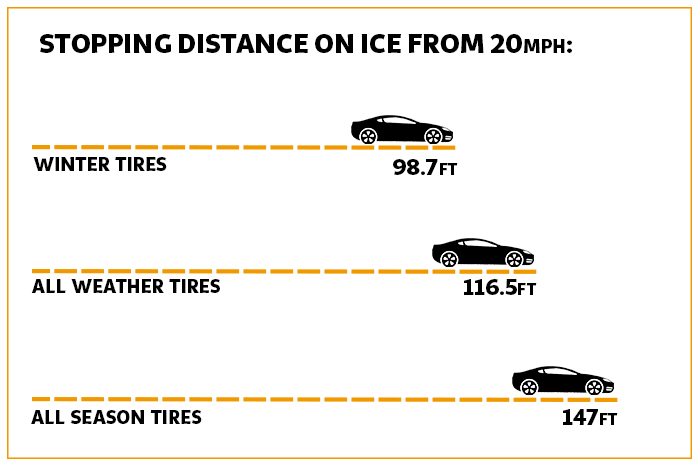
Investing in winter tires is worth it. Such tires are able to stop up to 50 feet shorter than their all season counterparts. This is crucial when it comes to winter weather driving, as your driving safety depends on it.
Another solution is to buy all weather tires since they have received the tire snowflake symbol for their cold temperature performance.
What if Winter Tire Laws Apply to You?
Due to the vast geographical area of our country, some states had to implement winter tire laws to ensure driving safety on motorways. These laws dictate the period when drivers must have winter-rated tires mounted on their vehicles.
By winter-rated we mean tires that sport the three-peak mountain and snowflake symbol. Tires of this type provide the necessary traction even in the harshest winter conditions. However, using dedicated winter tires in cold temperatures and all season tires in warmer conditions is the best solution. In this manner, you can ensure the longevity, fuel efficiency, comfort, and performance of both your all season and winter set.
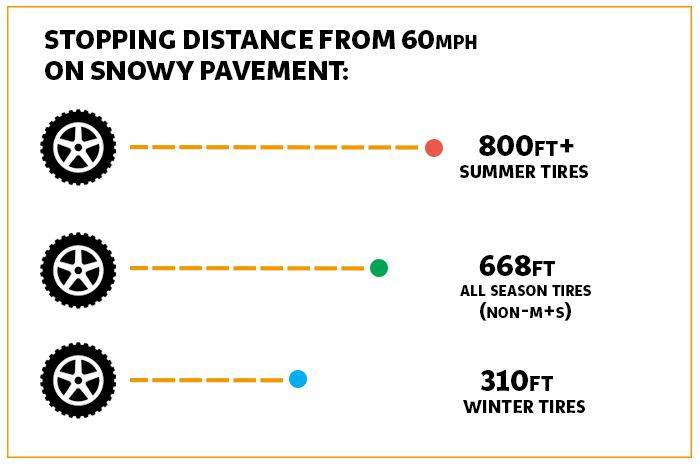
Alternatively, all weather three-peak mountain snowflake tires are also a good choice. These feature the 3PMS rating required by law, but they don't need to be switched when the seasons change. Still, keep in mind that their tread life length is shorter.
More Storage or More Tread Life? Choose Wisely
Another issue with switching seasonal tires is where can we store the set we are not using. The question of storage space is an issue for a lot of vehicle owners. If you don't have the space at home or don't already own a storage locker, renting one out just to store tires in it defeats the budget-friendly purpose.
Purchasing true year-round tires is a better solution in such cases. Even if their service life is not as good, they will provide the necessary traction in versatile weather conditions. This ensures a secure driving experience in dry, wet, and winter weather.
Frequently Asked Questions
How to Tell if Tires Are All Season?
Typically, an all season tire will sport M+S on its sidewall. This stands for Mud and Snow, indicating the tire's ability to handle such weather conditions. These tires are for dry, wet, and winter weather applications. However, some summer tires also sport the M+S rating.
Are All Weather Tires Good in Snow?
All weather tires sport the 3PMS (three-peak mountain and snowflake) symbol, which indicates its severe winter weather applications. These tires offer excellent traction in colder temperatures and on ice- and snow-covered road surfaces. They offer superb winter driving safety with their tread designs and compound blends.
How Long Do All-Weather Tires Last?
All weather tires are designed to focus on traction in the winter months. Therefore, their compounds tend to wear quicker in the warmer season. Still, most all weather tires that are for year-round use offer at least 50,000 and 60,000 miles of safe driving conditions.
Are All Weather Tires Good for Summer?
While all weather tire models are mostly known for their winter driving capabilities, they also offer excellent summer weather traction. Their tread design and compound blends are optimized to firmly grip the road in warm temperatures, while also offering great hydroplaning resistance.




Login and Registration Form